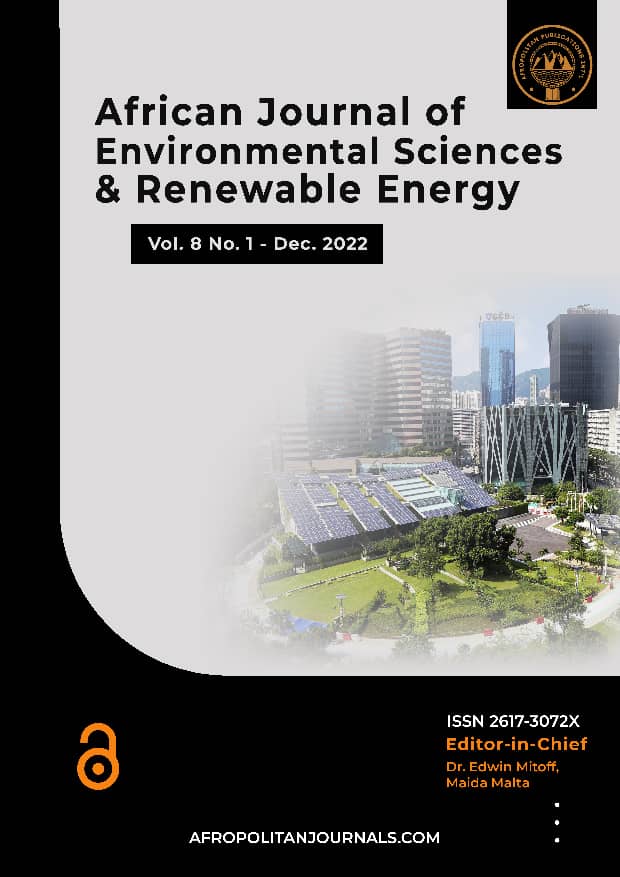Analysis of Flood Hazards on Urban Infrastructure in Minna City of Niger State, Nigeria
Main Article Content
Abstract
Hazard vulnerability and damages in terms of flooding affects housing, cars, roads, bridges and other assets in Minna. As more and more settlements were spreading in low-lying flood prone areas, they were becoming more exposed to physical vulnerability in Minna. This study aimed at examining the level of hazard vulnerability and extent of damages in relation to properties and infrastructure when flood occurs in Minna and suggests possible mitigating measures for disaster in Minna. Research design method was explored. The study population comprised of flood victims of IDPs camp in Minna which is 638. The sample-size for the study was 144. Purposive random sampling technique was used. The researcher designed a structured questionnaire. Focus group discussion and interview were used to collect factual information from 2012 to 2021 for data analysis. Mean statistic, t-test and ANOVA were used as methods of data analysis. The result of the study revealed that floods constituted an integral part of hazard vulnerability in Minna. It is evidently clear that when flood occurs in Minna countless losses are recorded. Therefore, actions to regulate floods disaster in Minna must be pragmatic to mitigate flood events in Minna since the prediction of severe flooding had been established in the study.
Downloads
Article Details

This work is licensed under a Creative Commons Attribution-NonCommercial-NoDerivatives 4.0 International License.
References
Abid S. K., Sulaiman N., Wei C. S. (2021). U N Flood vulnerability and resilience: exploring the factors that influence flooding in Sarawak Flood vulnerability and resilience: exploring the factors that influence flooding in Sarawak. IOP Conf. Ser. Earth Environ. Sci. 802 [Google Scholar]
Andrade M. M. N., de Szlafsztein, C. F. (2018). Vulnerability assessment including tangible and intangible components in the index composition: an Amazon case study of flooding and flash flooding. Sci. Total Environ.630:903–912. [PubMed] [Google Scholar]
Aroca-Jiménez E., Bodoque J. M., García J. A. (2020). How to construct and validate an Integrated Socio-Economic Vulnerability Index: implementation at regional scale in urban areas prone to flash flooding. Sci. Total Environ.746:140905. [PubMed] [Google Scholar]
Bajracharya, S. R., Khanal, N. R., Nepal, P., Rai, S. K., Ghimire, P. K., Pradhan, N. S. (2021). Community assessment of flood risks and early warning system in ratu watershed, Koshi basin, Nepal. Sustainability. 13(6) [Google Scholar]
Bera, M. K., Daněk, P. (2018). The perception of risk in the flood-prone area: a case study from the Czech municipality. Disaster Prev. Manag. 27(1):2–14. [Google Scholar]
Debionne, S., Ruin, I., Shabou, S., Lutoff, C., Creutin, J. D. (2016). Assessment of commuters' daily exposure to flash flooding over the roads of the Gard Region, France. Journal of Hydrology, 541, 636-648.
Dewan, T. H. (2015). Societal impacts and vulnerability to floods in Bangladesh and Nepal. Weather and Climate Extremes, 7, 36-42.
Diakakis, M., Deligiannakis, G., Katsetsiadou, K. N., Meleki, M. (2017). Mapping and classification of direct flood impacts in the complex conditions of an urban environment. The case study of the 2014 flood in Athens, Greece. Urban Water Journal, 14(10), 1065- 1074.
Dorbot, S., & Parkar, D. J. (2007). Advances and challenges in flash flood warnings. Environmental Hazards 7(3), 173- 178
Ebert, A., Kerle, N., Stein, A. (2009). Urban social vulnerability assessment with physical proxies and spatial metrics derived from air- and spaceborne imagery and GIS data. Nat. Hazards. 48(2):275–294. [Google Scholar]
Gebremedhin, E. T., Basco-Carrera, L., Jonoski, A., Iliffe, M., Winsemius, H. (2020). Crowdsourcing and interactive modelling for urban flood management. Journal of Flood Risk Management, 13(2), e12602. https://doi.org/10.1111/ jfr3.12602
GFDRR Annual Report, (2014a). Global Facility for Disaster Reduction and Recovery. Bringing Resilience to Scale. February 3, 2015. World Bank Headquarters 1818 H Street NW 20433
GFDRR's Annual Report, (2014b). Global Facility for Disaster Reduction and Recovery (GFDRR), sets out the progress and results that have been made from July 2013 to June 2014, and includes a highlight on the work of the ACP-EU NDRR Program on page 77.
Karagiorgos, K., Thaler, T., Heiser, M., Hube, J., Fuchs, S. (2016). Integrated flash flood vulnerability assessment: Insights from East Attica, Journal of Hydrology, 541, 553- 562.
Mohanty M. P., Simonovic S. P. (2021). Understanding dynamics of population flood exposure in Canada with multiple high-resolution population datasets. Sci. Total Environ.759:143559. [PubMed] [Google Scholar]
NEMA, n.d.a, National disaster response plan, Nigeria, viewed 23 August 2018, from https://www.preventionweb.net/files/21707nigeria.pdf. [Google Scholar]
Lianxiao, & Morimoto, T. (2019). Spatial analysis of social vulnerability to floods based on the MOVE framework and information entropy method: case study of Katsushika Ward, Tokyo. Sustainability,11(2) [Google Scholar]
Liu, W. C., Hsieh T. H., Liu H. M. (2021). Flood risk assessment in urban areas of southern Taiwan. Sustainability,13(6) [Google Scholar]
Musa, S. D., Shabu, T. (2019). Using geographic information system to evaluate land use and land cover affected by flooding in Adamawa State, Nigeria. Jàmbá J. Dis. Risk Stud. 11(1):1–11. [PMC free article] [PubMed] [Google Scholar]
OECD, (2012), “Disaster Risk Assessment and Risk Financing: A G20/OECD Methodological Framework”, OECD Publishing, Paris, www.oecd.org/gov/ risk/g20oecdframeworkfor disasterriskmanagement.htm.
Pereira, S., Diakakis, M., Deligiannakis, G., & Zezere, J., L. (2017). Comparing flood mortality in Portugal and Greece (Western and Eastern Mediterranean). International Journal of Risk Reduction, 22, 147-157.
Rehman S., Sahana M., Hong H., Sajjad H., Ahmed B. B. (2019). A systematic review on approaches and methods used for flood vulnerability assessment: framework for future research. Nat. Hazards. 96(2):975–998. [Google Scholar]
United Nations, (2018). World urbanization prospects: The 2018 revision. New York: United Nations Department of Economic and Social Affairs/Population Division.
World Bank, (2013). Catastrophe Deferred Drawdown Option: Product Note, The World Bank Treasury, Washington, DC, Retrieved from http://treasury.world bank.org/bdm/pdf/Handouts_Finance/CatDDO_Product_Note.pdf.
World Bank (2014).Assessing Post-Disaster Needs in Nigeria. Retrieved from www.preventionweb.net
WHO, (2012), Public health risk assessment and interventions. Flooding disaster: Nigeria, viewed 20 August 2018, from http://www.who.int/hac/crises/nga/RA_Nigeria_1Nov2012a.pdf.
Yin, J., Yu, D., Yin, Z., Liu, M., He, Q. (2016). Evaluating the impact and risk of the pluvial flash flood on intra-urban road network: A case study in the city centre of Shanghai, China. Journal of Hydrology, 537, 138-145.

